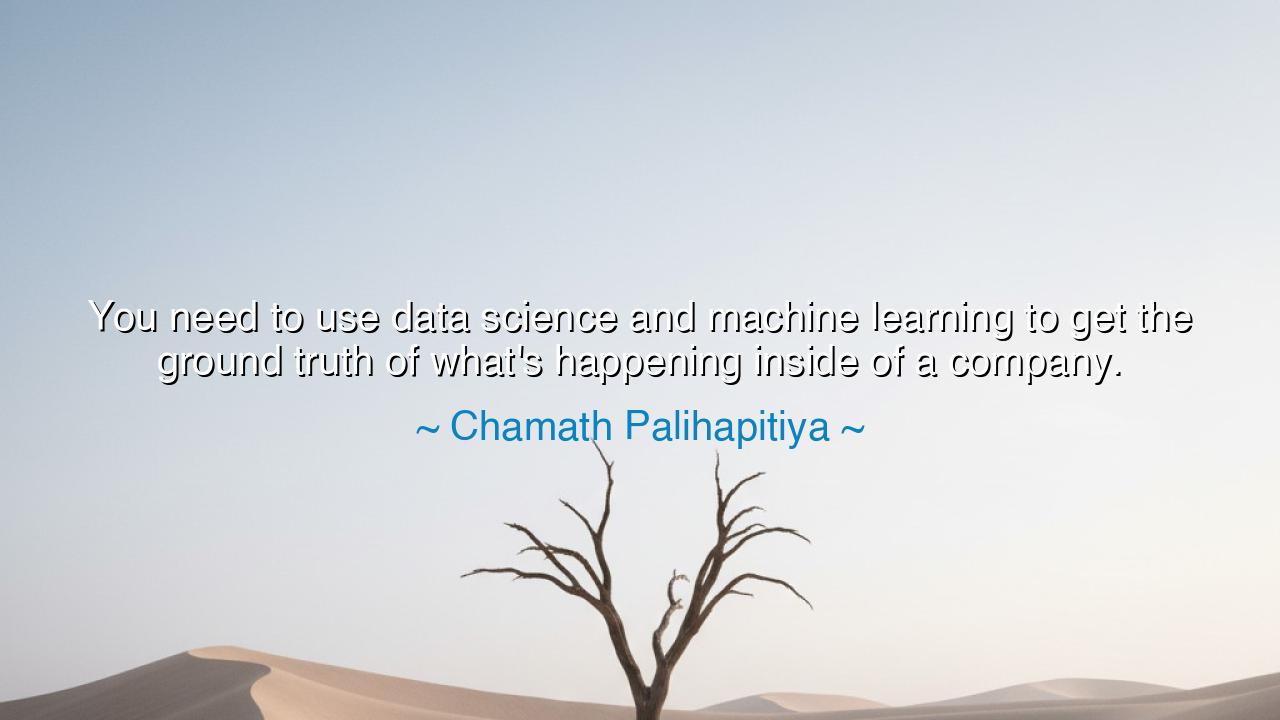
You need to use data science and machine learning to get the
You need to use data science and machine learning to get the ground truth of what's happening inside of a company.






Hear the counsel spoken like an inscription on basalt: “You need to use data science and machine learning to get the ground truth of what’s happening inside of a company.” In this saying, Chamath Palihapitiya reminds us that rumor is a fog and opinion a shifting dune, but numbers—rightly gathered, humbly modeled, and courageously interpreted—are the bedrock beneath the city. The world of enterprise is a crowded market of stories; only the measured story, tested against reality, can guide the caravan through heat and mirage.
What is this ground truth? It is the firm earth beneath the polished floors: the churn hidden behind cheerful surveys, the defect rate masked by a glossy launch, the silent carts abandoned at the edge of a checkout flow. To find it, we must send scouts into the data: logs, ledgers, timestamps, traces. Data science is the craft of these scouts—cleaning, joining, and framing the world so that signal stands apart from noise. Machine learning is the lens they bear—able to sift patterns too fine for the naked eye, to test a thousand hypotheses while managers sleep, to surface the subtle hinge on which outcomes turn.
Consider a tale from the age of steel and circuits. After the war, factories boomed, but many built on sand—quality swayed with the moods of the line. Into this tumult strode W. Edwards Deming with his quiet mathematics: control charts, variance, root cause. A Japanese automaker listened. They turned production into a living experiment, letting the numbers speak: when a process wavered, they asked the data why; when a fix worked, they proved it again. In time, the company grew famed for reliability—not by louder slogans but by deeper listening. This is the power of ground truth made sovereign in a company.
Yet beware the idol of dashboards. Numbers without meaning are a lantern with no oil. The wise know that data science must be yoked to domain knowledge, that machine learning must be tested in the field, that every metric can be gamed and every model can drift. Ground truth is not a wall to be admired but a well to be drawn from—frequently, skeptically, and with rituals that guard against self-deception. The map is updated, the compass recalibrated, the traveler corrected.
Why does this matter? Because inside every enterprise, power gathers around stories. The loud story, the fashionable story, the comforting story—each competes with the true story. When decisions steer billions of coins and the hours of countless workers, to act on illusion is to sin against the future. A culture that prizes ground truth turns confessions into advantages: teams admit where the funnel leaks, where the model fails, where the process frays—and then they fix them. In such places, candor is courage and improvement is law.
Let the lesson be engraved for leaders and apprentices alike: make truth measurable and make measurement merciful. Establish a common tongue—clear metrics, shared definitions—so that the warehouse and the boardroom speak the same sentence. Build pipelines that are clean and reproducible; test models out-of-sample; run experiments that can fail without punishment. In this way, machine learning becomes a servant of judgment, not its master; data science becomes a lantern for the cave, not a mask for the dark.
And for practical steps, carry these as provisions on the road: (1) Define the vital few metrics that tie directly to value; guard them from vanity. (2) Instrument every critical journey “end to end,” so what happens inside can be seen outside of anecdote. (3) Prefer experiments to arguments; let controlled trials settle debates swiftly. (4) Audit models for drift and bias; pair every algorithm with a human who owns its behavior. (5) Close the loop—every insight must meet an action, and every action must return to the data. Do this with patience and rigor, and your company will learn to hear its own heartbeat—steady, honest, unafraid—guided by the austere music of ground truth.






AAdministratorAdministrator
Welcome, honored guests. Please leave a comment, we will respond soon